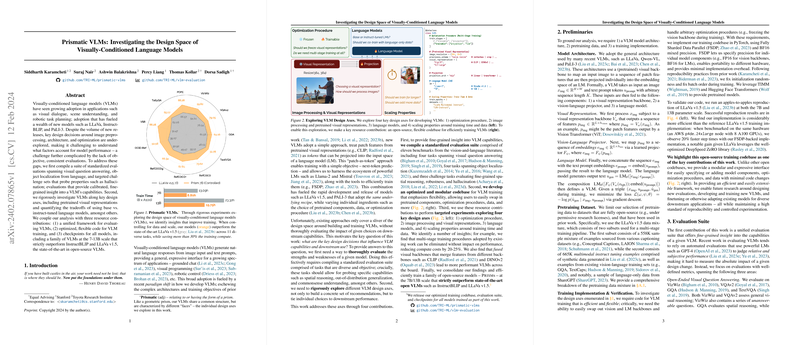Investigating the Design Space of Visually-Conditioned LLMs
Overview
The paper explores the complex landscape of visually-conditioned LLMs (VLMs), focusing on critical aspects of their design such as optimization procedures, visual representations, and LLM integration. It identifies best practices through rigorous experimentation, significantly enhancing model performance and efficiency. This paper emerges against the backdrop of burgeoning interest in VLMs, prompted by their vast potential in applications like visual dialogue and robotic task planning.
Key Findings and Contributions
- Standardized Evaluation Suite: The research presents a comprehensive evaluation framework that covers a wide range of capabilities from object localization to hallucination challenges. This initiative fills a critical gap in VLM assessment by providing calibrated insights into model competencies across diverse tasks.
- Investigation of Design Axes: Through targeted experiments, notable insights emerge regarding optimization, image processing, and representation. For instance, the paper challenges the necessity of multi-stage training, advocating for a more streamlined, single-stage approach that conserves computational resources without compromising performance.
- Visual Representation and Processing: The analysis underscores the superiority of vision-language contrastive models over other visual backbones and advocates for higher input image resolutions and naive image resizing for optimal performance.
- LLM Efficiency: The comparison between base and instruct-tuned LLMs reveals negligible differences in quantitative performance. However, base models demonstrate advantages in generating concise and relevant responses.
- Implications for Future Developments: The paper's findings have significant bearings on the practical deployment and theoretical understanding of VLMs. It suggests a pivot towards data diversity and training duration optimization to further enhance model capabilities.
- Resource Contributions: Beyond theoretical insights, the paper offers practical tools, including an open-source training codebase, a standardized evaluation suite, and access to trained model checkpoints. These resources are poised to facilitate future VLM research and development.
Evaluation and Experimental Insights
Comprehensive analyses conducted across multiple benchmarks highlight several key insights:
- Improvement with Single-Stage Training: A notable departure from multi-stage training paradigms, advocating for a streamlined approach that yields comparable or superior results while reducing computational demands.
- Ensemble Visual Representations: The paper explores the fusion of different visual representations, notably DINOv2 with CLIP or SigLIP models, demonstrating significant improvements in performance, especially in localization and challenge tasks.
- Scaling Image Resolution: Increasing input image resolution consistently enhances model performance across evaluations, albeit with higher computational costs.
- LLM Selection: The comparison between base LMs like Llama-2 and instruct-tuned models like Vicuna v1.5 shows minimal performance differences, with base models somewhat more resistant to hallucination.
Limitations and Future Directions
While the paper robustly explores VLM design spaces, limitations in architecture generality and evaluation scope are acknowledged. Future research could extend to alternative architectures and develop more comprehensive evaluation frameworks, particularly for assessing model interaction in realistic scenarios.
Conclusion
This paper advances the understanding of key design decisions impacting VLM performance and provides a valuable resource base for the broader research community. Through carefully designed experiments and comprehensive evaluations, it lays a foundation for future explorations in the domain of visually-conditioned LLMs, significantly contributing to the advancement of generative AI practices.
